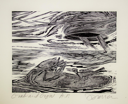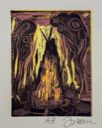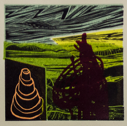Madison Ke Francis
American
(Memphis, Tennessee, 1945 - )
Artists such as Ke Francis delight in artistic creativity and are not satisfied with a single mode of expression. They revel in matching a message to a medium, in finding just the right means to convey an idea. Francis is an artist of many gifts—writer, storyteller, bookmaker, painter, printmaker, and sculptor. Having such an extensive creative arsenal at one’s disposal is daunting and requires high energy, but Francis has apparently rarely met a medium he did not want to make his own.
Raised in the South, Francis is both in and of the region, and he uses his many expressive formats to address themes that are at once local and universal. Originally from Mississippi, he migrated to Florida, where he taught in the art department at the University of Central Florida in Orlando, and managed the publication of books and prints through the university’s Flying Horse Press and his own Hoopsnake Press. He returned to Mississippi and lives in Tupulo.
Given the many media at Francis’s command, it is no wonder that he does not embrace one coherent style. His creations are sometimes complementary—for example, a fictional story may incorporate printed images within an artist’s book. Equally often, however, objects stand alone, and the viewer is left to navigate the symbolism of motifs layered upon the paper or canvas. The images may be representational, but they are also disparate, attaining whatever meaning they may have solely through the artist’s selection and compositional context.
Howard Risatti has noted that this process of combining seemingly unrelated images echoes the sense of discontinuity in our modern, advertising-saturated world. “We are constantly bombarded by a stream of repeating images promoting every imaginable product. Images of every kind and type are now being dislocated from their historical contexts. In mass culture and mass society, images are being emptied of their resonance, reduced, literally to little more than one dimensional props without any of the weight or density originally intended by their authors.” (1)
To truly understand Francis’s message, however, one must bear in mind two key aspects of his approach: first, his appreciation of humor and his recognition of its important role in art and life; and second, his belief that the images he uses are “predestined” to be combined, and he is the conduit for their synthesis. The link between these two concepts, as he explains it, has to do with the viewer’s willingness to approach art humorously, that is, without prejudice, and accept the imagery at face value. “You are supposed to enjoy the moment…you don’t need to dwell on how the [visual image] got there or where it’s going later.” (2)
(1) Howard Risatti, “Ke Francis: A View from America,” in Ke Francis (Montgomery: The Montgomery Museum of Fine Arts, 2002), p. 6. Risatti categorizes Francis’s approach as consistent with Postmodernism, in which the artist uses unrelated images from multiple sources and periods of art
(2) Telephone interview with Francis conducted by Tara Sartorius, curator of education, December 2003, transcript, artist’s file, Montgomery Museum of Fine Arts Archives.
American Paintings from the Montgomery Museum of Fine Arts, 2006, cat. no. 105, p. 242.
American
(Memphis, Tennessee, 1945 - )
Artists such as Ke Francis delight in artistic creativity and are not satisfied with a single mode of expression. They revel in matching a message to a medium, in finding just the right means to convey an idea. Francis is an artist of many gifts—writer, storyteller, bookmaker, painter, printmaker, and sculptor. Having such an extensive creative arsenal at one’s disposal is daunting and requires high energy, but Francis has apparently rarely met a medium he did not want to make his own.
Raised in the South, Francis is both in and of the region, and he uses his many expressive formats to address themes that are at once local and universal. Originally from Mississippi, he migrated to Florida, where he taught in the art department at the University of Central Florida in Orlando, and managed the publication of books and prints through the university’s Flying Horse Press and his own Hoopsnake Press. He returned to Mississippi and lives in Tupulo.
Given the many media at Francis’s command, it is no wonder that he does not embrace one coherent style. His creations are sometimes complementary—for example, a fictional story may incorporate printed images within an artist’s book. Equally often, however, objects stand alone, and the viewer is left to navigate the symbolism of motifs layered upon the paper or canvas. The images may be representational, but they are also disparate, attaining whatever meaning they may have solely through the artist’s selection and compositional context.
Howard Risatti has noted that this process of combining seemingly unrelated images echoes the sense of discontinuity in our modern, advertising-saturated world. “We are constantly bombarded by a stream of repeating images promoting every imaginable product. Images of every kind and type are now being dislocated from their historical contexts. In mass culture and mass society, images are being emptied of their resonance, reduced, literally to little more than one dimensional props without any of the weight or density originally intended by their authors.” (1)
To truly understand Francis’s message, however, one must bear in mind two key aspects of his approach: first, his appreciation of humor and his recognition of its important role in art and life; and second, his belief that the images he uses are “predestined” to be combined, and he is the conduit for their synthesis. The link between these two concepts, as he explains it, has to do with the viewer’s willingness to approach art humorously, that is, without prejudice, and accept the imagery at face value. “You are supposed to enjoy the moment…you don’t need to dwell on how the [visual image] got there or where it’s going later.” (2)
(1) Howard Risatti, “Ke Francis: A View from America,” in Ke Francis (Montgomery: The Montgomery Museum of Fine Arts, 2002), p. 6. Risatti categorizes Francis’s approach as consistent with Postmodernism, in which the artist uses unrelated images from multiple sources and periods of art
(2) Telephone interview with Francis conducted by Tara Sartorius, curator of education, December 2003, transcript, artist’s file, Montgomery Museum of Fine Arts Archives.
American Paintings from the Montgomery Museum of Fine Arts, 2006, cat. no. 105, p. 242.
Artist Objects
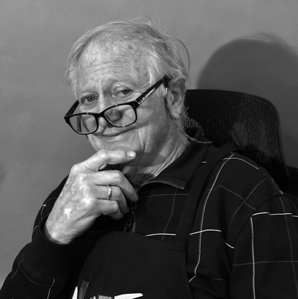
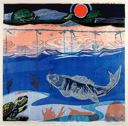
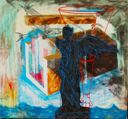


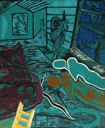
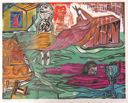


![Image of Whirlygig [sic] Weather Gauge](/media/Thumbnails/2021/2021.0005.0005.or1.png)
